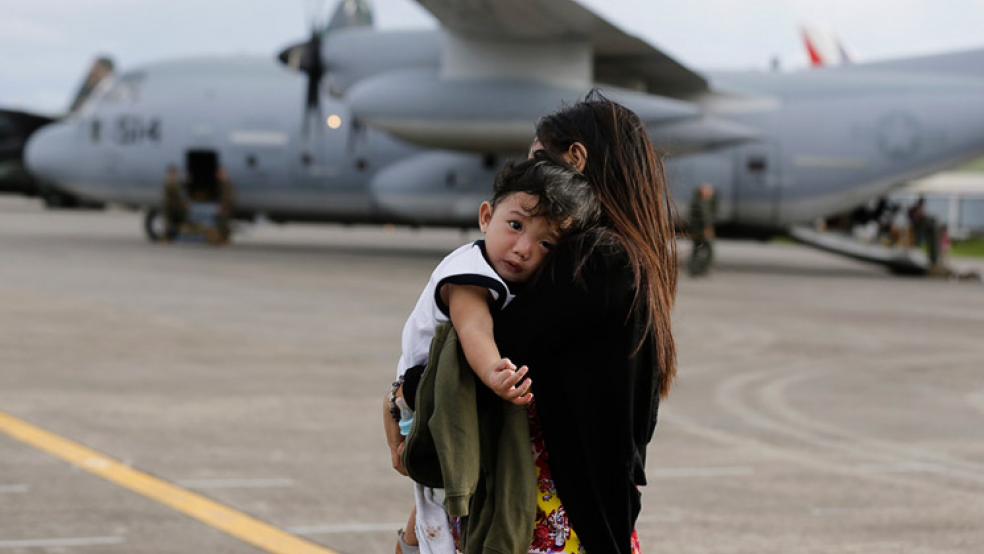The U.S. military often gets a bad rap overseas – blamed by foreign powers for civilian deaths and collateral damage inflicted in conflict zones.
Yet no other institution is better equipped than the American military to respond to a humanitarian calamity in remote outposts. It is often the first to react to natural disasters, such as the monster typhoon that struck the Philippines last weekend, bringing catastrophic loss of life and destruction.
The U.S. government allotted more than $4 billion to disaster relief worldwide in fiscal year 2012, according to an August 2013 Congressional Research Service report. The Defense Dept. has the flexibility to spend more, depending on the scope of the disasters. "Congress has consistently supported humanitarian efforts as a means of responding to natural disasters (such as floods and earthquakes) and man-made crises (such as war) in the short term, taking the lead and promoting a U.S. presence," according to the report.
Related: 14 Devastating Natural Disasters
Right now, the focus is on a response to Typhoon Haiyan, the storm that killed 1,183 people, according to figures on Wednesday morning. The Center for Disaster Philanthropy says the typhoon, which cut across the center of the Philippines with winds of up to 200 miles per hour, destroyed 70 to 80 percent of the structures in its path. The U.S. has pledged $20 million in immediate aid to the Philippines. By comparison, China has said it's pledging an initial $200,000, including $100,000 from its government and another $100,000 from the Chinese Red Cross.
Two U.S. C-130 cargo planes were the first to arrive with relief supplies on Monday. The Marines landed at Tacloban, a city on the Philippines’ eastern coast, but with roads and bridges washed away and downed trees and powerlines, troops were having difficulty in getting supplies to victims.
DOD has dispatched additional aircraft to the area to conduct search-and-rescue missions and deliver supplies to civilians cut off by the storm. The Pentagon announced that it deployed an aircraft carrier, the USS George Washington, and several other smaller vessels to the region.
The George Washington carries 5,000 sailors and more than 80 aircraft.
“The Defense Department is continuing to work closely with the Philippine government to determine what, if any, additional assets may be required,” Pentagon press secretary George Little said Monday night.
This is the latest in a long series of U.S. aid efforts in Asia. The military sent an aircraft carrier and planes to Indonesia following the tsunami there in 2004, and deployed 240,000 troops to Japan to assist in relief efforts after the 2011 earthquake. The U.S. government has responded to more than 40 disasters in the Philippines alone since 1990, as requested by that country's government, according to DOD.
Steep Economic Impact
An early analysis by risk assessment firm Kinetic Analysis estimated that the typhoon disaster will create an economic loss of $14 billion – or nearly 6 percent of the Philippines’ $250 billion annual economy. Moreover, a recent report by Munich Re, a firm that conducts insurance analysis, found that the economies of developing countries like the Philippines are especially susceptible to natural disasters of any magnitude. The group found that countries with emerging economies lose 2.9 percent of their Gross Domestic Product when disaster strikes, compared to just 0.8 percent in developed countries.
While “emerging countries already have a relatively substantial capital base, they often lack the resources or necessary effectiveness in their administration to protect themselves better against the consequences of natural catastrophes,” Munich RE’s chief economist Michael Menhart said in an October 30 report.
Menhart also warned about the consequences of a disaster similar to the latest typhoon. “On top of this, there is the urbanization of coastal regions, which, in Asia, for instance, are at great risk from cyclones.”
Top Reads from The Fiscal Times:
- No Hope Left for Obamacare’s Website, Techies Say
- Bill Clinton Just Undercut Obama’s Health Plan
- Vets’ Programs on the Chopping Block As DOD Cuts Back





